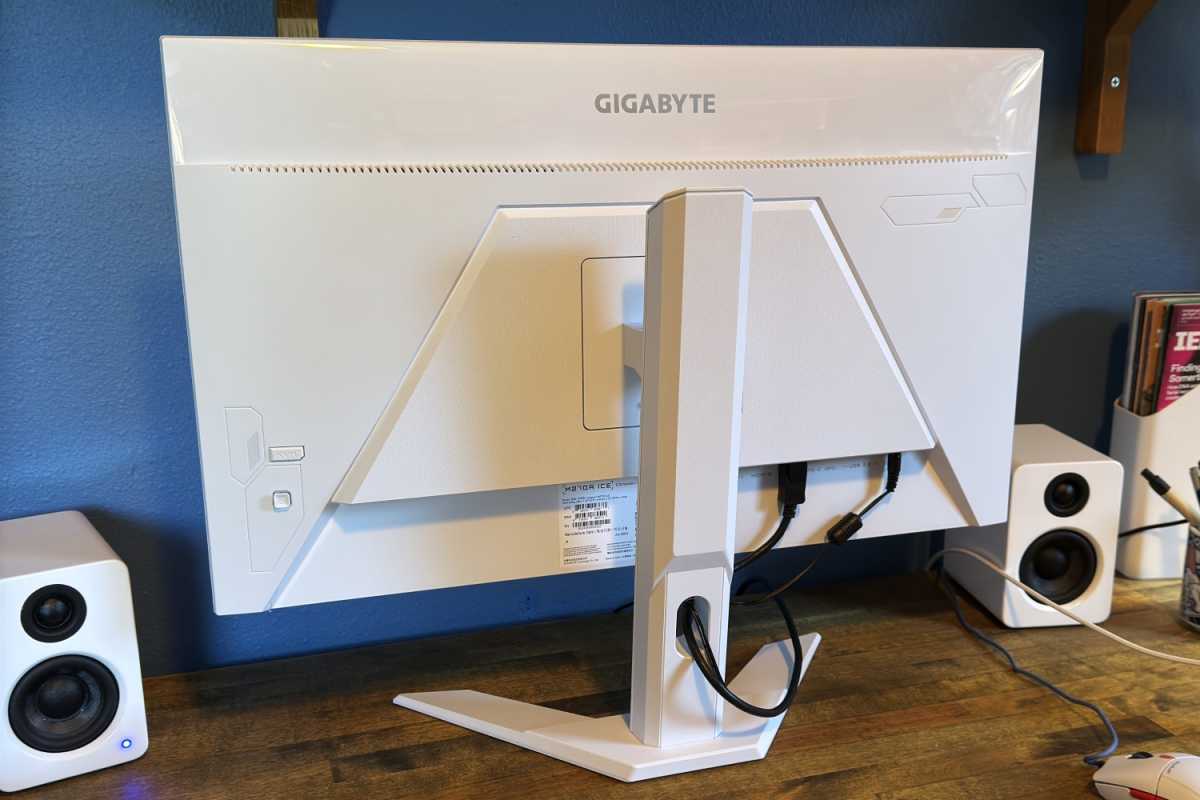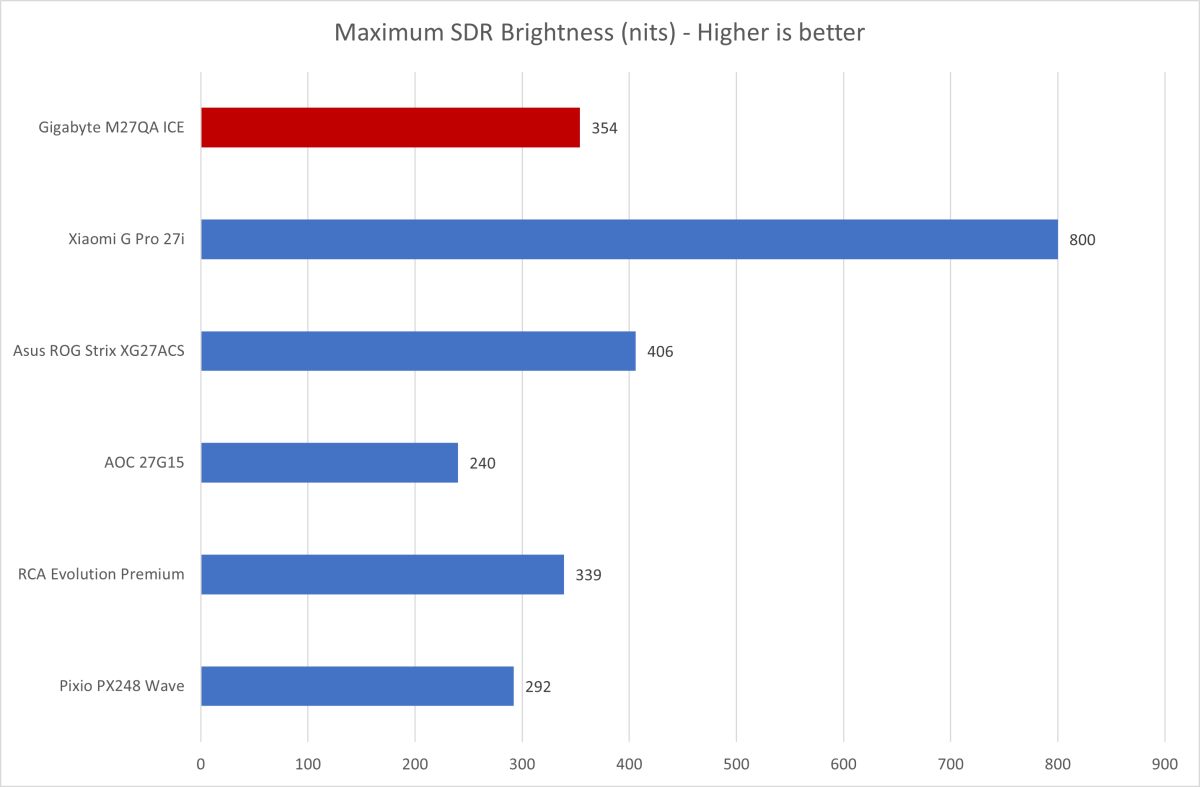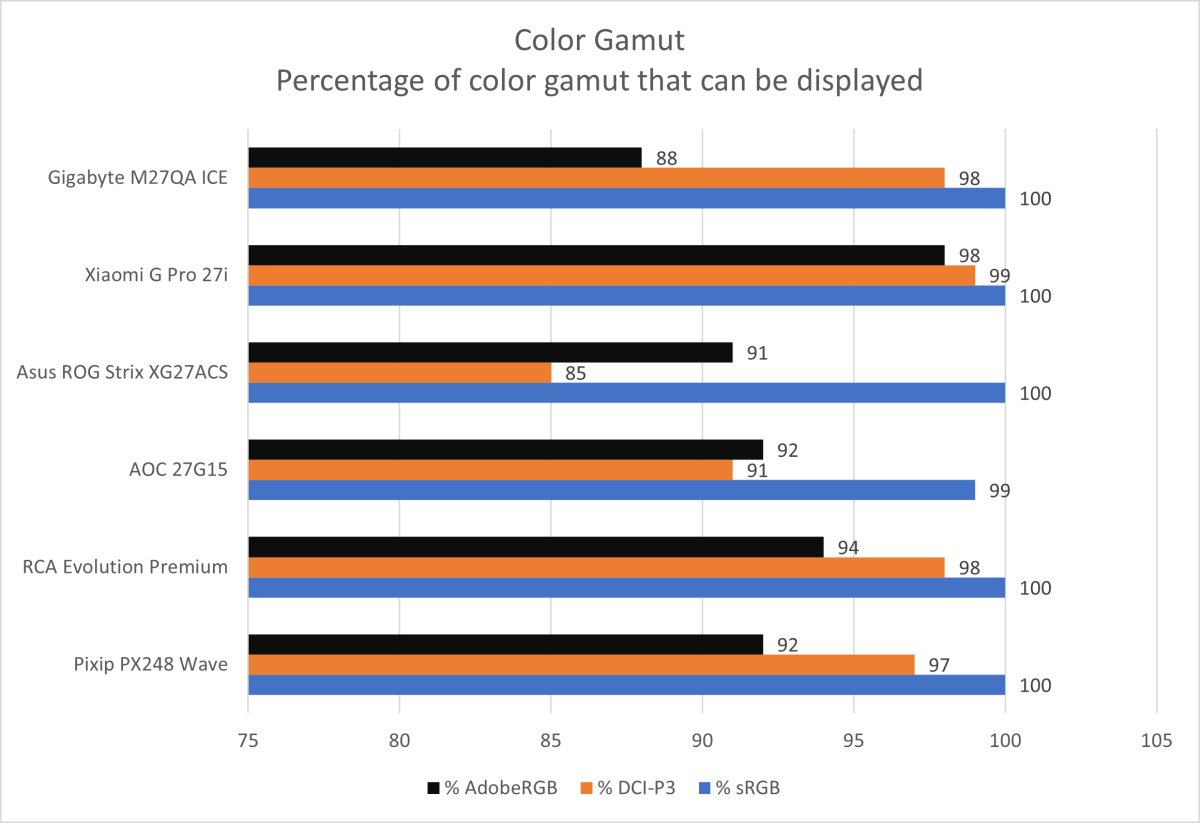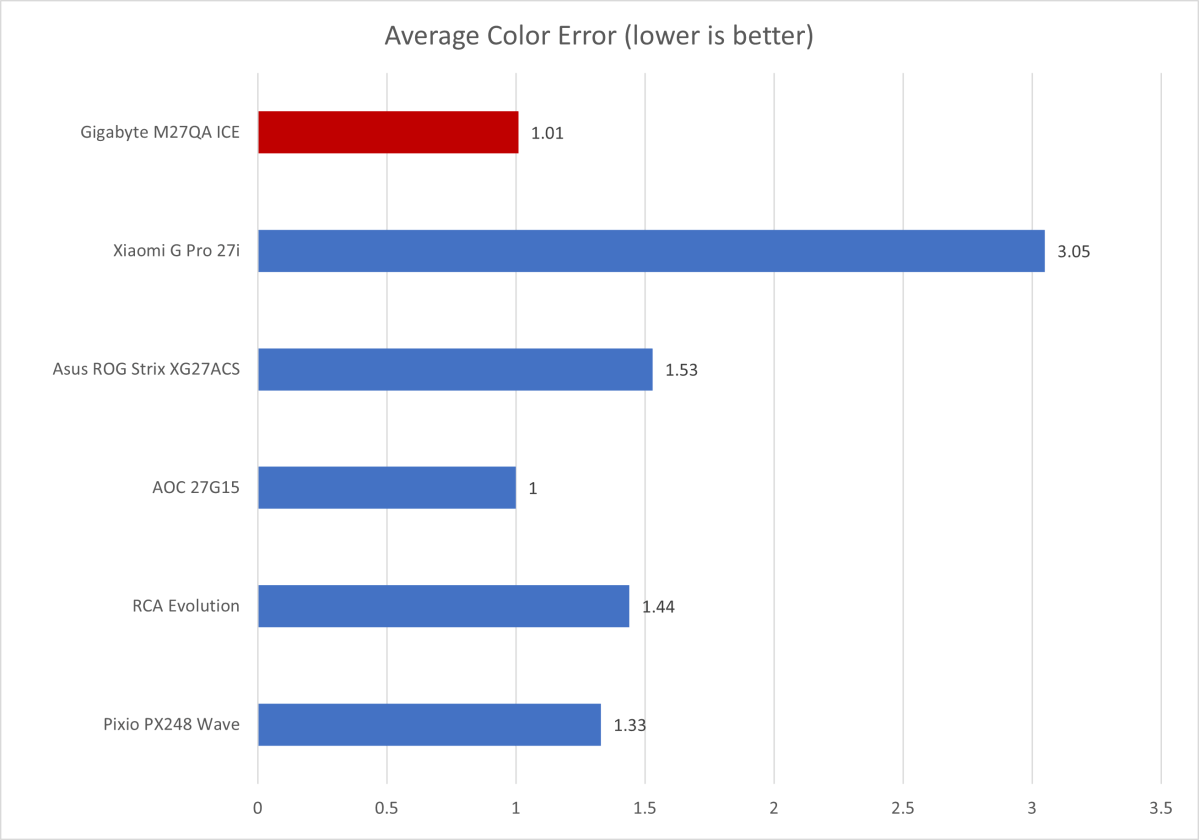Gigabyte M27QA ICE review: A monitor built for your cozy gaming den

 Image: Matthew Smith / Foundry
Image: Matthew Smith / FoundryAt a glance
Expert’s Rating
Pros
Attractive colorway and designGood range of video inputs including USB-CExcellent color gamut and accuracy
Cons
USB-C port only provides 10 watts of powerMediocre contrast ratioHDR performance falls short of Mini-LED competitors
Our Verdict
The Gigabyte M27QA ICE stands out from peers with an attractive white colorway that should fit perfectly in a home office or cozy gaming den. However, the monitor’s image quality is less alluring than its design.
Price When Reviewed
This value will show the geolocated pricing text for product undefined
Best Pricing Today
Price When Reviewed
299.99
Best Prices Today: Gigabyte M27QA ICE
RetailerPrice
 $279.99View DealPrice comparison from over 24,000 stores worldwideProductPricePrice comparison from Backmarket
$279.99View DealPrice comparison from over 24,000 stores worldwideProductPricePrice comparison from Backmarket
Monitor manufacturers are starting to wise up to a fact that keyboard and mouse makers have long understood: People like personalization. The charcoal shade that monitors frequently use is okay but doesn’t stand out next to a mechanical keyboard with custom keycaps. The Gigabyte M27QA ICE is one of several new budget monitors that try to fix the situation with an uncommon colorway (in this case, white) and alluring design.
Gigabyte M27QA ICE specs and features
The Gigabyte M27QA ICE’s basic specifications are typical for a 27-inch monitor sold around $300. It has a resolution of 2560×1440, an IPS display panel, and a refresh rate of up to 180Hz. Dozens, if not hundreds, of price-competitive monitors offer similar specs.
[ Today is Amazon Prime Big Deal Days! Our editorial team lists the best tech deals here.
]Display size: 27-inch 16:10 widescreenNative resolution: 2560×1440Panel type: SS IPSRefresh rate: Up to 180HzAdaptive sync: AMD FreeSyncHDR: Yes, VESA DisplayHDR 400 CertifiedPorts: 2x HDMI 2.0, 1x DisplayPort 1.4, 1x USB Type-C with DisplayPort Alternate Mode and 10 watts Power Delivery, 1x USB-B 3.2 upstream, 2x USB-A 3.2 downstream, 1x headphone jackVESA mount: 100x100mmSpeakers: NonePrice: $299.99 MSRP
The monitor’s connectivity is a bit stronger than usual, as it provides a USB-C port, though it’s unfortunately limited to 10 watts of USB Power Delivery. The monitor also has a KVM switch feature alongside two USB-A ports.
Further reading: See our roundup of the best gaming monitors to learn about competing products.
Gigabyte M27QA ICE design
The first thing you notice is obvious: The Gigabyte M27QA ICE is white. While PC World has reviewed a few monitors available in an alternative white colorway, like the Pixio PX248 Wave, most monitors still stick to a basic, boring black. And you know what? The M27QA ICE looks nice. It fits well into setups embracing other white peripherals or a minimalist, cozy vibe. For some, the color alone will be half the reason to buy this monitor.

Matthew Smith / Foundry
Matthew Smith / Foundry
Matthew Smith / Foundry
Color aside, the Gigabyte M27QA is fairly basic. The rear of the panel is attractive and makes good use of texture to liven up the look, but the monitor lacks RGB-LED lighting. Material quality is typical—not bad, but nothing special.
The bundled monitor stand is a mix. It’s sturdy, and while the base is a bit wide, it’s also flat, which means you can easily place notebooks or knick-knacks on top of it. The stand adjusts easily for height and tilt. However, it doesn’t swivel or rotate into portrait mode, a feature many similarly priced monitors offer. The monitor has the typical 100x100mm VESA mount, so a third-party monitor stand or arm is an option.
Gigabyte M27QA ICE connectivity and menus
The Gigabyte M27QA ICE’s video connectivity includes two HDMI 2.0 ports, one DisplayPort 1.4, and one USB-C port with DisplayPort alternate mode. That’s a total of four video inputs, which is solid for an inexpensive gaming monitor.
However, the HDMI 2.0 ports can’t handle 2560×1440 at 180Hz, which means only the DisplayPort and USB-C ports can access the monitor’s full refresh rate. That’s a minor disappointment.
The USB-C port connects to two USB-A 3.2 ports but only offers 10-watt power delivery, so it can’t charge a laptop. This is another small disappointment, since it means you’ll still need to connect a power brick to a laptop connected to the monitor over USB-C.
The USB-A 3.2 ports can also connect via the USB-B upstream port. Additionally, the monitor includes a KVM switch for seamlessly switching between devices when a wired keyboard and mouse are connected.

Matthew Smith / Foundry
Matthew Smith / Foundry
Matthew Smith / Foundry
The monitor’s on-screen menus are navigated using a joystick located on the right side of the screen. This placement is convenient for right-handed users but not ideal for left-handed ones. The joystick is very responsive, at least.
Gigabyte also provides a helpful Windows software utility to adjust monitor settings. This is common among major monitor brands. However, the Gigabyte’s lower price means you might consider it alongside brands that don’t have a Windows monitor utility, like Spectre and Pixio. In that case, Gigabyte’s software gives the M27QA ICE an edge in ease-of-use.
Gigabyte’s on-screen menus are well-organized, though the small font size and low contrast can make them difficult to read. The monitor offers a wide range of image quality features, such as color saturation, temperature, and gamma adjustments.
It also has gaming features like a crosshair, timer, picture-in-picture, and a dashboard displaying system information, including CPU and GPU temperatures. Additionally, the monitor has a black equalizer to enhance visibility in shadows and an aim stabilizer for improved motion clarity while aiming. These features are typical among gaming monitors, though the on-screen system information is less common.
Speakers are absent, though, so you will need to use external speakers or headphones.
Gigabyte’s software gives the M27QA ICE an edge in ease-of-use.
Gigabyte M27QA ICE SDR image quality
The specifications of the Gigabyte M27QA ICE are standard for a mid-range 27-inch gaming monitor. It features an IPS panel with quick pixel response times and a resolution of 2560×1440. However, it lacks newer technologies like a Mini-LED backlight or OLED display panel, leading to a predictably average image quality.

Matthew Smith / Foundry
Matthew Smith / Foundry
Matthew Smith / Foundry
The M27QA ICE performs well in our brightness test, with it reaching a peak SDR brightness of 354 nits. This is impressive for a budget monitor and ensures usability even in well-lit rooms, though positioning it near sunlit windows may still be a problem. The screen also has a matte finish to minimize glare.
But what about the Xiaomi G Pro 27i, which absolutely slays in this test? That’s due to its Mini-LED backlight, which Xiaomi does not limit when displaying SDR content.
However, it’s worth noting that an overly bright monitor can lead to eye strain. So, while the Xiaomi’s brightness can have a purpose if you’re planning to game in an atrium, it’s not as advantageous as it appears on the graph.

Matthew Smith / Foundry
Matthew Smith / Foundry
Matthew Smith / Foundry
Next up is contrast, which highlights distinct differences. The M27QA ICE’s contrast performs adequately for a budget gaming monitor and surpasses some options like the RCA Evolution Premium.
However, the Xiaomi and AOC 27G15 are significantly better in this area. The Xiaomi achieves great contrast with a Mini-LED backlight, while the AOC 27G15 uses a Vertical Alignment (VA) display panel. Both alternatives have their downsides, as they land behind the M27QA ICE in motion clarity. But if you want a more lifelike and immersive image, they’re a better pick.

Matthew Smith / Foundry
Matthew Smith / Foundry
Matthew Smith / Foundry
Color gamut is a strength for the M27QA ICE, as it hit 100 percent of sRGB, 98 percent of DCI-P3, and 88 percent of AdobeRGB. Color performance like this was reserved to high-end photography monitors just five years ago, so it’s great to see it on a budget monitor.
Competitors also tend to perform well, though, so Gigabyte doesn’t have much advantage. The RCA Evolution Premium and Xiaomi find an edge against the Gigabyte, as they provide a notable improvement in the AdobeRGB color gamut.
For gamers, it’s all a bit of a wash. All three monitors will look similarly vivid and punchy. Content creators, however, could find an advantage in broader AdobeRGB cover, as it means the RCA and Xiaomi can display colors not visible on the Gigabyte.

Matthew Smith / Foundry
Matthew Smith / Foundry
Matthew Smith / Foundry
The M27QA ICE does well in color accuracy, as it effectively ties the AOC 27G15 for first place. A color error this low means the monitor will looks realistic straight away and should work for nearly any purpose, whether it’s gaming or content creation.
Gigabyte’s good color accuracy is supported by a gamma curve result of 2.3 and color temperature of 6600K. These are close to our targets of gamma 2.2 and a color temperature of 6500K. Critical viewers might feel the Gigabyte is a tad darker than usual, but it’s subtle. The color temperature of 6600K is slightly cooler than our preference, but also hard to notice. And as mentioned, the Gigabyte has a good range of image quality adjustments to help owners tune the monitor to their preference.
Sharpness is good. The 27-inch panel has a resolution of 2560×1440, which works out to a pixel density of about 109 pixels per inch. A 27-inch 4K panel is much sharper at 163 pixels per inch, but the M27QA ICE still looks crisp. 1440p resolution is also a good match for the monitor’s target audience. Shoppers looking to buy a gaming monitor priced at $300 are unlikely to pair it with a high-end video card capable of playing games at 4K resolution.
Overall, the Gigabyte M27QA ICE offers solid yet modest image quality. It avoids any major problems but also fails to stand out in any one area. The big problem for Gigabyte, I think, is the encroachment of budget Mini-LED monitors. These have their own flaws but, even accounting for them, a monitor like the Xiaomi G Pro 27i offers a brighter SDR image with a wider color gamut (though its color error might give content creators pause).
Gigabyte M27QA ICE HDR image quality
The Gigabyte M27QA ICE can display HDR but holds VESA DisplayHDR 400 certification, which is the lowest tier of this certification. Because of that, the M27QA ICE isn’t a great HDR display.
Brightness is an issue. The monitor’s maximum HDR brightness reaches only 384 nits, which isn’t enough to deliver the luminance expected from HDR. Bright objects often appear as uniform masses lacking intricate detail.
Contrast also falls short. The absence of a Mini-LED backlight or OLED display panel means the monitor can only increase brightness by boosting the entire backlight, resulting in a washed-out appearance in darker scenes. In the movie Interstellar, the inky blackness of space looked more like a gentle fog.
The Gigabyte’s performance is not surprising given the monitor’s price point. However, budget Mini-LED monitors like the Xiaomi G Pro 27i demonstrate that better performance is possible in this price bracket.
Gigabyte M27QA ICE motion performance
The Gigabyte M27QA ICE has a maximum refresh rate of 180Hz (though only 144Hz over HDMI 2.0) and promises a pixel response time as low as one millisecond. These specifications lead to good motion clarity, though it’s hardly the best available today.
Scrolling test images from League of Legends and DOTA 2 revealed that character silhouettes and terrain details were easy to make out. Yet smaller details, like character names and hitpoint bars, were difficult to understand in motion. In shooters, it’s generally possible to glimpse fast-moving enemies and objects, but they may elude your sight if they’re far away or moving slowly.
Gigabyte advertises official support for AMD FreeSync. As with most modern monitors, this means the M27QA ICE should work with the Nvidia G-Sync Compatible and VESA Adapative Sync standards, though it’s not guaranteed. In my experience, it’s rare to see any problems when using Nvidia cards with an AMD FreeSync monitor, or vice versa.
While the M27QA ICE doesn’t raise the bar on motion clarity, its performance is more than adequate for most situations and will look truly spectacular if you’re upgrading from a 60Hz display. The M27QA ICE will have an edge against price-competitive monitors with a VA panel, like the AOC 27G15, as those can suffer a “dark smear” issue caused by poor pixel response times when transitioning from darker colors.
Should you buy the Gigabyte M27QA ICE?
The Gigabyte M27QA ICE is a fine but unexceptional example of a mid-range gaming monitor that’s also well-suited to content creation and general use. It has a clear, sharp image, good motion clarity, and great color performance in SDR. The monitor’s white colorway also stands out and should fit into any home office or cozy gaming den.
However, the monitor’s contrast ratio and HDR performance can’t match price-comparable Mini-LED displays. And while the monitor has USB-C, it only provides 10 watts of power.
Because of that, your buying decision will hinge on price. The M27QA ICE has a MSRP of $300, which feels a bit steep, but it’s already reduced to $280, and I expect it’ll dip lower this holiday season. It’s a good buy at $250 or less. Above that, it’s still a solid monitor, but struggles to stand out from competitors.
Best Prices Today: Gigabyte M27QA ICE
RetailerPrice
 $279.99View DealPrice comparison from over 24,000 stores worldwideProductPricePrice comparison from Backmarket
$279.99View DealPrice comparison from over 24,000 stores worldwideProductPricePrice comparison from Backmarket
Author: Matthew S. Smith
Matthew S. Smith is a freelance technology journalist with 15 years of experience reviewing consumer electronics. In addition to PCWorld, his work can be found on Wired, Ars Technica, Digital Trends, Reviewed, IGN, and Lifewire. Matthew also covers AI and the metaverse for IEEE Spectrum and runs Computer Gaming Yesterday, a YouTube channel devoted to PC gaming history.
Recent stories by Matthew S. Smith:
Best home office monitors 2024: Displays that get the job doneBest portable monitors 2024: Displays that go with youLenovo ThinkVision M14t review: A pricey portable monitor with touch






